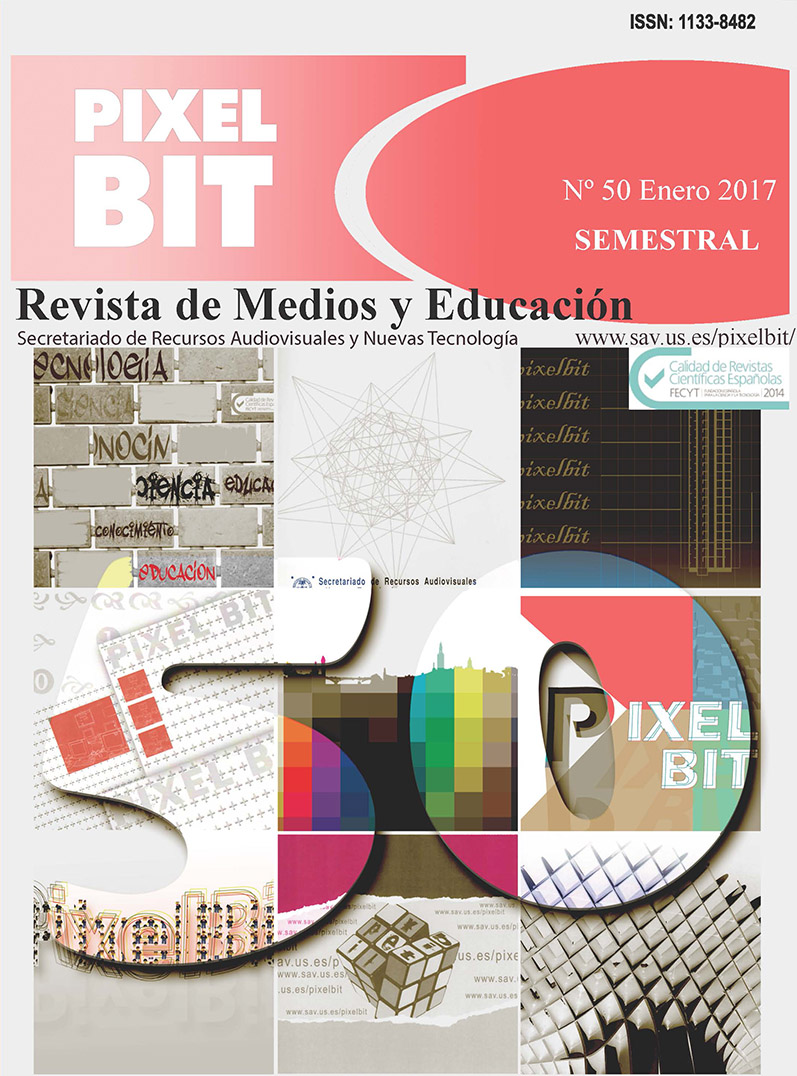Resumen
Los entornos virtuales multiusuario facilitan el diseño de estrategias de aprendizaje en escenarios inmersivos y colaborativos en red. En ellos, el concepto de presencia social, basado en la proyección social y emocional del usuario dentro del entorno virtual, puede tener un impacto positivo en el aprendizaje. Por ello, abordamos el análisis de la presencial social de los usuarios en estos entornos en una experiencia con 52 alumnos de Pedagogía de la Universitat Rovira i Virgili en que se buscaba comprender e interpretar como desarrollan la presencia social en este entorno. Nuestros resultados evidencian el desarrollo de una clara presencia social positiva en las tres categorías fundamentales: expresión emocional, comunicación abierta y cohesión de grupo.Citas
Allmendinger, K. (2010). Social Presence in Synchronous Virtual Learning Situations: The Role of Nonverbal Signals Displayed by Avatars. Educational Psychology Review, 22(1), 41–56. doi: 10.1007/s10648-010-9117-8
Arbaugh, J. B. & Hwang, A. (2006). Does “teaching presence” exist in online MBA courses?. The Internet and Higher Education, 9(1), 9-21. doi: 10.1016/j.iheduc.2005.12.001
Atkins, C. (2009). Virtual Experience: Observations on Second Life. En M. Purvis y B. T. R. Savarimuthu (Eds.), Computer- Mediated social networking (pp.7-17). Heidelberg: Springer.
Biocca, F. & Harms, C. (2002). Defining and measuring social presence: Contribution to the networked minds theory and measure. Proceedings of PRESENCE, 1-36.
Bowers, J. & Kumar, P. (2015). Students' Perceptions of Teaching and Social Presence: A Comparative Analysis of Face-to-Face and Online Learning Environments. International Journal of Web-Based Learning and Teaching Technologies, 10(1), 27-44. doi: 10.4018/ijwltt.2015010103
Caspi, A. & Blau, I. (2008). Social presence in online discussion groups: Testing three conceptions and their relations to perceived learning. Social Psychology of Education, 11(3), 323-346. Doi: 10.1007/s11218-008-9054-2
Castronova, E. (2005). Synthetic Worlds: the Business and the Culture of Online Games. Chicago: University of Chicago Press.
De Freitas, S. (2006). Learning in immersive worlds. A review of game-based learning. London: JISC E-Learning Programme.
Esteve, V., Cela, J. M. & Gisbert, M. (2013). The role of presence in a simulation lab for educator professional development. En 3rd European Immersive Education Summit, London.
Esteve, V., González, J., Gisbert, M. & Cela-Ranilla, J. (2015). La presencia social en una experiencia docente universitaria en entornos virtuales 3D. En XVIII Congreso Internacional EDUTEC 2015: Educación y Tecnología desde una visión Transformadora, Riobamba, Ecuador.
Esteve, F. M., Esteve, V. & Gisbert, M. (2012). Simul@: el uso de mundos virtuales para la adquisición de competencias transversales en la universidad. Universitas Tarraconensis: Revista de ciències de l’educació, 37(2), 7-23.
Garrison, D. R. (2007). Online Community of Inquiry Review: Social, Cognitive, and Teaching Presence Issues. Journal of Asynchronous Learning Networks, 11(1), 61-72.
Gilbert, R. L. (2011). The PROSE Project : Conducting in-world psychological research on 3D virtual worlds. Virtual Worlds Research, 4 (1), 4–17. doi: http://dx.doi.org/10.4101/jvwr.v4i1.2108
Kim, D. & Mousavizadeh, M. (2015). A Study of Antecedents of Sense of Presence in Virtual World: Virtual Presence vs. Social Presence. AMCIS 2015 Proceedings
Leong, P. (2011). Role of social presence and cognitive absorption in online learning environments. Distance Education, 32(1), 5–28. doi:10.1080/01587919.2011.565495
Mansour, S., Bennett, L. & Rude, C. (2009). How the use of Second Life affects e-learners’ perceptions of social interaction in online courses. Journal of Systemics, Cybernetics & Informatics, 7(2), 1-6.
McKerlich, R., & Anderson, T. (2007). Community of inquiry and learning in immersive environments. Journal of Asynchronous Learning Networks, 11(4), 35-52.
Slater, M. & Steed, A. (2000). A Virtual Presence Counter. Presence: Teleoperators and Virtual Environments, 9(5), 413-434. doi:10.1162/105474600566925
Yee, N. (2006). The Demographics, Motivations and Derived Experiences of Users of Massively-Multiuser Online Graphical Environments. Presence: Teleoperators and Virtual Environments, 15(3), 309-329 doi:10.1162/pres.15.3.309
Zhang, C. (2009). Understanding the Impact of Virtual World Environment on Social and Cognitive processes in Learning (doctoral thesis). University of Nebraska, Estados Unidos de América.

